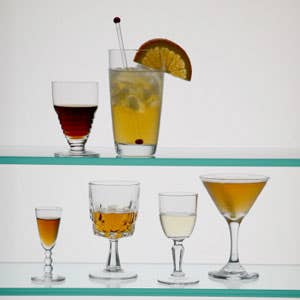
Civilized Company
Before the First World War, it seemed that whenever a well-bred English speaker met a well-bred English speaker, a glass of sherry, the famous fortified white wine from Spain, followed. And, when the weather was warm, just about every adult in the United States, whether or not he or she knew how to use a dessert fork, liked a sherry cobbler--a tipple that's simply a largish glass of dry amontillado or oloroso sherry shaken up with a bit of sugar, a slice or two of orange, and plenty of ice. The sportier types might even have had their sherry mixed into an honest-to-god cocktail (a favorite of the 1890s was the bamboo, a dry and refreshing mix of sherry, dry vermouth, and bitters). However it was taken, southwestern Spain's contribution to human contentment was an essential part of sophisticated drinking. Small wonder: peerlessly dry when you wanted something dry, rich and sweet when you wanted that, this nutty-tasting wine—produced in several distinct styles in and around the Andalusian city of Jerez de la Frontera—was (and still is) the perfect thing to have before a meal, or after it, or really anytime at all, especially in the summer.
In a sense, sherry's popularity was also its undoing. By the early years of the 20th century, growing demand in Britain had led to a flood of cheap imitations that damaged the wine's reputation. Then came the trenches and the mud and the blood. I suppose that anything bound up too closely with an ostensibly civilized society that could send a generation of young men to slaughter was destined to suffer in the reckoning that ensued, and indeed, for many, sherry went the way of tonal music and virginity. You can witness it happening in a scene, set in the 1920s, from Evelyn Waugh's novel Brideshead Revisited, wherein the cosmopolitan Anthony Blanche orders gin cocktails for himself and Charles Ryder, the book's rather more conservative narrator, with the comment "I expect you would prefer sherry, but, my dear Charles, you are not going to have sherry."
The drink didn't fare much better on this side of the Atlantic, where, in the face of Prohibition, a younger, more cynical generation had developed a thirst for harder stuff. Take, for example, Parties, the bohemian intellectual Carl Van Vechten's feverish and booze-sodden novel, published in 1930; in that skewering of New York society, the only people who drink sherry are a monocled German undergraduate and somebody's mother.
Still, sherry didn't disappear altogether. In 1920, the English literary critic George Saintsbury gave sherry pride of place in his classic of wine writing Notes on a Cellar-Book, with the statement that "no reasonable person should quarrel if we begin with sherry." Of course, he was in his 70s at the time. This is pretty much how things would go for the rest of the 20th century: though Britain remained a key export market for sherry, among youthful drinkers on both sides of the Atlantic the drink came to be viewed the way Latin is: an arcane sort of thing that might be nice to know but is hardly indispensable.
The eccentricities inherent in the way sherry is classified could be partly to blame. As Saintsbury observed, the drink is "singularly various in kind", and sorting out all the finos and olorosos and palo cortados, all the amontillados and manzanillas and pedro ximenezes (see Tasting Notes), was enough to send many consumers back to the reassuring familiarity of a burgundy or a manhattan. Then there is the fact that producers add a little grape brandy to the wine to stop fermentation. No matter that some California cabernets ship out at a higher proof than many sherries; for a lot of wine drinkers, fortified was a dirty word.
What's more, in Spain's sherry bodegas, or cellars, the vintners store the wine in a collection of barrels, called a solera, taking off only part of the oldest barrels' sherry for bottling and refilling those barrels from the next-oldest ones, and so on. Where is the fun, wine lovers asked themselves, if there aren't any vintages to fetishize? Throw in levels of sweetness that can vary from none whatsoever to dessert-in-a-glass, and many consumers ended up with the sense that sherry wasn't a true wine.
Funny what a little shift in perspective will do, though. These days, classic cocktails are back. Bitters, rye whiskey, vermouths—anything that has pre-Prohibition roots—are getting a second look, and so is sherry. The popularity of Spanish tapas, traditionally consumed with sherry, has helped to raise the drink's profile, too, but those are only superficial reasons why sherry deserves a comeback. Sure, the wine has impeccable old-school credentials, and, yes, a lot of the traits that kept sherry on the sidelines—the mellow, oxidized flavors; the sweetness and the added alcohol—no longer seem so outdated or esoteric. But ultimately, the allure of this drink is as simple and timeless as that of all the finest wines and spirits: it's artisanally made, unique in its flavors and colors, and, most important, deeply pleasurable to drink.
True, the nomenclature can still be tricky, but then, so is telling your grand cru from your cru bourgeois. And, after all, that's what study is for, preferably with a nice glass of amontillado at one's elbow. It might be too much to hope for a second coming of the sherry cobbler as America's summer drink of choice, but a boy can dream, can't he?
Keep Reading
Continue to Next Story










